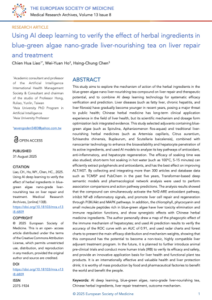Home > Medical Research Archives > Theme Issues > Challenges and Opprtunities in Health Disparities
Theme Issue:
Challenges and Opprtunities in Health Disparities
Health disparities remain a pressing global concern, shaped by the interplay of socioeconomic status, geography, race, ethnicity, and access to healthcare. This theme issue explores the complex challenges that perpetuate inequities in health outcomes, while also highlighting emerging opportunities to bridge these gaps.
Contributions address critical topics such as the role of social determinants of health, barriers to preventive care, and the impact of structural inequities on disease prevalence and treatment outcomes. Advances in digital health, community-based interventions, and culturally tailored care models demonstrate how innovation can drive more equitable healthcare delivery.
The collection further examines the importance of policy reforms, interdisciplinary collaboration, and patient engagement in reducing disparities. Ethical considerations and the imperative for inclusivity underscore the need for sustainable, patient-centered strategies.
Together, these perspectives illuminate pathways toward achieving health equity, emphasizing both the obstacles to be overcome and the transformative potential of innovation and collaboration.
This theme issue was organized in collaboration with the Committee.
Contents
Research Article
Bayesian mediation modeling of racial disparity for maternal birth outcomes in United States
Our study shows that His bundle pacing is safe and has a high success rate provided specialized methods for intracardiac recording are used instead of systems for routine pacemaker implants. The lower all-cause mortality of His bundle pacing makes it imperative that we adapt available recording methods, in use for electrophysiology studies, to simplify His bundle pacing and increase its adoption.
By James Thompson - College of Veterinary Medicine and Biomedical Science, Texas A&M University
Research Article
Black/African Americans (AA) and Disproportionate Burden of SARS-COV-2 (COVID-19) Mortality in the United States
Substantial racial/ethnic disparities are observed in COVID-19 CF and mortality with Blacks/AA disproportionately affected across the United States.
By Laurens Holmes, Jr., Keerti Deepika, Janille Williams, Benjamin Ogundele, Glen Philipcien, Michael Enwere, Shikha Jain, Naresh Dasari, Ram Sanjiv Alur, Ramesh Adhikari
Research Article
DRIVE for Health Equity: Tailoring Quality Improvement, Clinical Education, and Community Engagement to Improve Type 2 Diabetes (T2DM) Outcomes for Minoritized Communities in Oakland, California
SHC’s DRIVE program improved T2DM outcomes through community involvement, quality improvement, and culturally tailored education. This initiative highlighted the importance of addressing health inequities and barriers in diabetes care through culturally sensitive techniques and sustained interventions. DRIVE effectively reduced disparities and promoted sustainable health outcomes among minority groups. Collaborative efforts enhanced trust and demonstrated the advancement of health equity through tailored interventions, with DRIVE providing a flexible and sustainable framework for tailoring interventions to community needs. These findings underscored the need for individualized, culturally competent diabetes care, continuous education, community engagement, and equitable resource access to support communities of color and ethnic minorities in managing T2DM effectively.
By Leslie Zuniga-Rivas, MPH, Henry Nuss, PhD., Adewale Lawrence, MD, MS, Laura Hernandez, Nushrat Sultana, MPH, Kristen Stevens Hobbs, MPH, CPH., DeLorean Ruffin, DrPH, MPH., Bishop Erik O. Nation, Aneesa Choudhry, MPH, and Laura Lee Hal, PhD.
Research Article
Advancing Health Equity: A Safety Net Hospital Perspective
By Abha Agrawal, MD, FACP, FACHE Chief Medical Officer, Humboldt Park Health, Chicago IL USA
Research Article
Barriers to Mammography Screening among Black Women at a Community Health Center in South Florida, USA
By Tarsha Jones, PhD, MSN, RN, PHNA-BC, Karen Wisdom-Chambers, DNP, APRN, FNP-BC, PMHNP-BC, Christine E. Lynn, Katherine Freeman, Dr. P.H., Karethy Edwards, DrPH, APRN, FNP-BC, FAAN
Research Article
Perceived Barriers to Treating Patients with Disabilities and Complex Health Needs Reported by Oral Health Professionals: A Scoping Review
By Xinyuan YANG, Michelle CHOW, Yuti GANDHI, Jennifer NGUYEN, Brian TO - Melbourne Dental School, University of Melbourne, Mathew Albert Wei Ting LIM
Research Article
A Review Article on Impact of Coronavirus Disease on Patients in the Health Care Setting: A Tale or Reality
By Ehiremhen Ozah - Urology Unit, Department of Surgery, Irrua Specialist Teaching Hospital, Irrua, Edo State, Nigeria. Esteem Tagar - General Surgery Unit, Department of Surgery, Irrua Specialist Teaching Hospital, Irrua, Edo State, Nigeria. William Akerele - Paediatric Surgery Unit, Department of Surgery, Irrua Specialist Teaching Hospital, Irrua, Edo State, Nigeria
Research Article
Expansion of the 340B Program’s Child Sites and Health Disparities Among Medicare Beneficiaries with Asthma
By Amanda S. Tripp, PhD, MPH; Grecia Marrufo, PhD; Thomas Kornfield, MPP; and Melissa Morley, PhD - Avalere Health, 1201 New York Avenue NW, Suite 1000, Washington, DC 20005 Abra Yeh, MPP; Donald Nichols, PhD - Genentech, Inc., 1 DNA Way, South San Francisco, CA 94080
Research Article
SARS-CoV-2 (COVID-19) Morbidity and Chronic Disease (Type II Diabetes –T2D) and Pancreatic Carcinoma: Clinco-epidemiologic Perspective
By Laurens Holmes, Jr., Kerti Deepika, Janille Williams, Benjamin Ogundele, Glen Philipcien, Michael Enwere, Shikha Jain, Naresh Dasari, Ram Sanjiv Alur, Ramesh Adhikari, Franciscan Health, Gbadebo Ogungbade
Research Article
Redefining Health through Multidisciplinary Obesity Prevention and Treatment in the United Arab Emirates
By Maryam Alkhatry, Hayder M. Hamadi, Abdulwahid Alwahedi, Zaki Al Muzaki, Fathi Ahmed, Bashar Almasri, Fedaa Housen, Mohammed Bataweel, Eman Alabar, Hisham eltayeb
Research Article
A Review of Racial and Ethnic Disparities in Obesity Treatment
By Raj Lele, Sheryl Haller, Kate David, Gaby Gutierrez, Shurouk Kattan Rahmani, M Rami Bailony
Research Article
Uncovering Disparities in Vision Health in Rural vs Urban Areas: Is There a Difference?
By Karen Allison, Chanbin Lee—Department of Ophthalmology, University of Rochester, Rochester, NY; Leah Greene, Deepkumar Patel—Department of Clinical Research, New York Ophthalmology Associates PLCC, NYC, NY.
Research Article
Human Freedom from Algorithmic Bias: What is the role of Accountability in addressing Health Disparities?
By Sajda Qureshi, PhD - D.B. and Paula Varner Professor of Information Systems, Director ITD mHealth Cloud Computing Lab, Department of Information Systems & Quantitative Analysis, College of Information Science & Technology. University of Nebraska at Omaha, 6001 Dodge Street, Omaha, NE 68182-0116; Blessing Oladokun - Data Analytics Graduate Assistant, ITD mHealth Cloud Computing Lab, Department of Information Systems & Quantitative Analysis, College of Information Science & Technology. University of Nebraska at Omaha, 6001 Dodge Street, Omaha, NE 68182-0116
Research Article
Navigating Mental Health Amidst COVID-19: Understanding Symptoms, Sociodemographic Patterns, and Practice Implications
By Stephanie F. Dailey - College of Education and Human Development, George Mason University, Fairfax, Virginia. 4400 University Drive MSN 1H1 Fairfax, VA 22030.
Research Article
Can Black Americans Reduce or Eliminate Racial Health Disparities by Getting More Sun Exposure?
By David G. Hoel
Research Article
Racial Disparities in Telemedicine Uptake during the COVID-19 Pandemic among Patients with Hematologic Malignancies in the United States
By Natalia Neparidze, MD, Krystal W. Lau, PhD, Xiaoliang Wang, PhD, Scott Huntington, MD, MPH, Omer Jamy, MD, Gregory S. Calip, PharmD, MPH, PhD, Harsh Shah, DO, Deborah M. Stephens, DO, Rebecca Miksad, MD, MPH, Ravi B. Parikh, MD, MPP, Samuel Takvorian, MD, MSHP, Gaurav Goyal, MD, Erlene Seymour, MD
Research Article
Medical Mistrust on Prostate Cancer Screening: A mixed method study among African Americans, Caribbean immigrants and African immigrants
By Malika Nipher, PhD, MPH—RAND Corporation, 1776 Main St., Santa Monica, CA 90401, USA; Lisa Roberts, DrPH, RN—Loma Linda University School of Nursing, 11262 Campus Street, West Hall, Loma Linda, CA 92350 USA; Alemi Qais, PhD, MPH, MBA - Loma Linda University, School of Behavioral Health, 11065 Campus St., Loma Linda, CA 92350; Casiano Carlos A, PhD - Center for Health Disparities and Molecular Medicine, Loma Linda University School of Medicine, 11085 Campus Street, Mortensen Hall, Loma Linda, CA 92350 USA; Montgomery Susanne, MS, MPH, PhD- Loma Linda University, School of Behavioral Health, 11065 Campus St., Loma Linda, CA 92350 USA ; Center for Health Disparities and Molecular Medicine, Loma Linda University School of Medicine, 11085 Campus Street, Mortensen Hall, Loma Linda, CA 92350 USA
Research Article
The Apportionment of Pharmacogenomic Variation: Race, Ethnicity, and Adverse Drug Reactions
By I. King Jordan - School of Biological Sciences, Georgia Institute of Technology, Atlanta, Georgia, USA; IHRC-Georgia Tech Applied Bioinformatics Laboratory, Atlanta, Georgia, USA; PanAmerican Bioinformatics Institute, Valle del Cauca, Cali, Colombia; Shivam Sharma and Shashwat Deepali Nagar - School of Biological Sciences, Georgia Institute of Technology, Atlanta, Georgia, USA; Leonardo Mariño-Ramírez - PanAmerican Bioinformatics Institute, Valle del Cauca, Cali, Colombia; National Institute on Minority Health and Health Disparities, National Institutes of Health, Bethesda, Maryland, USA
Research Article
Language Preference and its Moderating Role in Coping with Stress: The Hispanic Community Health Study/Study of Latinos
Stress and stressful events are widely accepted risk factors for cardiometabolic diseases, including coronary heart disease and diabetes. As language plays a seminal role in development and regulation of emotions and appraisals of stressful situations, it may contribute to documented differences in the stress-cardiometabolic disease association across ethnic groups. We investigated associations between language preferences (Spanish vs English) and downstream health consequences of stress.
By Morgan Gianola, Maria M. Llabre and Neil Schneiderman - University of Miami, Department of Psychology; Linda C. Gallo - San Diego State University, Department of Psychology; Martha L. Daviglus - University of Illinois, College of Medicine; Daniela Sotres-Alvarez University of North Carolina, Department of Biostatistics
Research Article
Epidemiologic Risk Modeling of Disproportionate Burden of SARS-CoV-2 Case Positivity and COVID-19 Mortality among Blacks/African Americans in Washington DC, USA
There were racial/ethnic disparities in SARS-Cov-2 case positivity, COVID-19 mortality and mortality risk, which was higher among Blacks/AA relative to their White counterparts in Washington DC. Additionally, mortality was higher in male compared to female as well as DC-ward variation by mortality.


